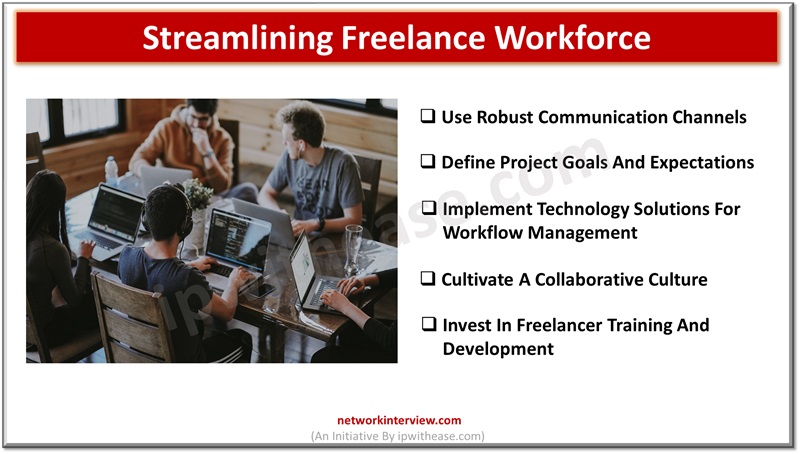
Streamlining freelance workforce: 5 proven ways to do so
The freelance workforce has become an integral part of the modern business landscape. As organizations increasingly turn to freelancers for specialized skills, managing and optimizing this flexible workforce becomes crucial. This article explores five proven ways to streamline your freelance workforce and improve collaboration.
Five proven ways to streamline your freelance workforce
Here are five proven ways to streamline your freelance workforce.
1. Use robust communication channels
Effective communication is vital to successful collaboration, especially in a remote freelance environment. Establishing clear communication channels is essential to keeping everyone on the same page. Use project management tools to centralize communication and task tracking. Regularly scheduled meetings, whether through video conferencing or other means, help promote connection and accountability among team members.
Creating a transparent communication framework helps freelancers understand project requirements and receive timely feedback. It enhances productivity and helps meet specific payment expectations. Clear communication ensures freelancers know project milestones and can align their efforts accordingly.
2. Define project goals and expectations
To streamline the process, define the scope of work, project timelines, and expected deliverables. Provide freelancers with detailed project briefs, objectives, and key performance indicators (KPIs).
When freelancers comprehensively understand project expectations, they can align their efforts more effectively. Clarity reduces the chances of misunderstandings and revisions. Moreover, when freelancers meet specific project goals, it becomes easier for organizations to create a mutually beneficial relationship.
3. Implement technology solutions for workflow management
Implementing dedicated platforms for project and workflow management can enhance efficiency. Tools like Upwork, Freelancer, or Fiverr allow businesses to find, hire, and manage freelancers effortlessly. These platforms allow one to have access to progress reports and milestone tracking.
Having access to progress reports is crucial for freelancers and organizations. Freelancers can showcase their achievements and contributions, while businesses can track project milestones and ensure alignment with deadlines. Transparency promotes trust and accountability, making it easier to execute projects.
4. Cultivate a collaborative culture
Building a collaborative culture is essential for a successful freelance workforce. Encourage open communication and create a sense of community among freelancers. You can achieve this through virtual team-building activities and shared project spaces. Platforms like Google Workspace or Microsoft Teams provide a virtual space where freelancers can collaborate in real-time.
A collaborative culture boosts creativity and problem-solving. When freelancers feel like integral members of a team, they are more likely to go above and beyond to meet project expectations. Collaborative spirit contributes to a smoother workflow and positively impacts the quality of deliverables.
5. Invest in freelancer training and development
Continuous learning is critical in today’s evolving business world. Investing in freelancer training and development benefits the individuals and enhances the capabilities of your freelance workforce. Provide access to relevant training materials and resources that align with your organization’s industry and goals.
Upskilling freelancers help businesses ensure their workforce remains competitive and adaptable. Skilled freelancers can deliver higher value to make organizations more willing to compensate them according to their expertise.
Pitfalls to avoid when managing freelancers
While leveraging freelancers can bring numerous benefits, organizations must avoid these common pitfalls to ensure successful collaboration.
1. Lack of clear communication
Ambiguities in project requirements can lead to misunderstandings and subpar deliverables. To overcome this, establish transparent communication channels and encourage freelancers to seek clarification. Regular check-ins and status updates help maintain a cohesive understanding of project expectations.
2. Ignoring scope creep
Clearly define project scopes and deliverables from the outset to mitigate the risk of scope creep. Regularly review project progress against the agreed-upon scope and address deviations promptly to avoid additional costs and timeline extensions.
3. Overlooking legal aspects
Freelancer contracts and legal considerations are often overlooked, leading to potential disputes and complications. In written agreements, outline expectations, payment terms, and project timelines. Ensure compliance with labor laws and intellectual property regulations to protect both parties. A well-drafted contract provides a solid foundation for a successful freelance engagement.
4. Failing to provide adequate resources
Freelancers require the necessary tools and resources to deliver optimal results. Failing to provide access to essential software or data can impact productivity. Prioritize setting up freelancers with the tools needed and offer guidance on organizational processes to integrate them into your workflow.
Bottom line
Streamlining a freelance workforce requires a strategic approach that includes communication, clarity, technology, and more. Implementing these proven methods can help organizations create an environment where freelancers thrive and projects succeed. As the freelance world grows, mastering these techniques will be essential for remaining ahead in the competitive business world.
Continue Reading:
Top 10 Free Conference Call Services
10 Most Popular Robotic Process Automation RPA Tools



